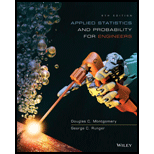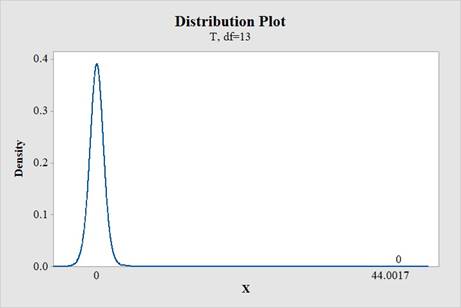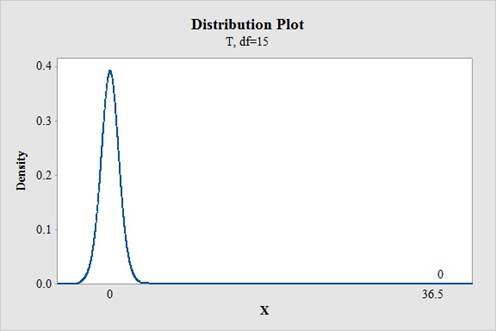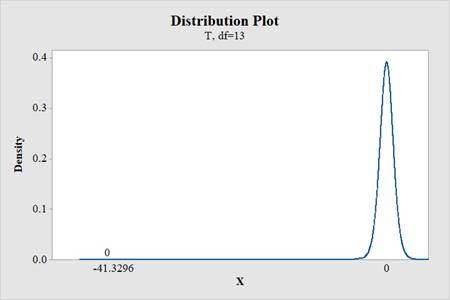
Concept explainers
a.
Find the missing quantities.
a.
Answer to Problem 106SE
The filled
| Predictor | Coefficient | SE Coefficient | T | P | |||
| Constant | 517.46 | 11.76 | 44.0017 | 0 | |||
| 11.4720 | 0.314 | 36.50 | 0 | ||||
| –8.1378 | 0.1969 | –41.3296 | 0 | ||||
| 10.8565 | 0.6652 | 16.3207 | 0 | ||||
| Analysis of Variance | |||||||
| Source | DF | SS | MS | F | P | ||
| Regression | 3 | 347,300 | 115,767 | 1,102.543 | 0 | ||
| Residual Error | 16 | 1,683 | 105 | ||||
| Total | 19 | 348,983 | |||||
Explanation of Solution
Calculation:
An incomplete regression analysis table is given.
Multiple linear regression model:
A multiple linear regression model is given as
The t-statistic is obtained as,
The test statistic
In the given problem the regression equation is
Hence, there are 3 regressors and
Now, using the given information it can be found that,
| Predictor | Coefficient | SE Coefficient | |
| Constant | 517.46 | 11.76 | |
| 11.4720 | 36.50 | ||
| –8.1378 | 0.1969 | ||
| 10.8565 | 0.6652 |
The total observation is 19. Thus,
In the given problem, the degrees of freedom for t-statistic is,
P- value:
Software procedure:
Step by step procedure to obtain the P- value using the MINITAB software is given below:
- Choose Graph > Probability Distribution Plot choose View Probability > OK.
- From Distribution, choose ‘t’ distribution.
- Enter Degree of freedom as 15.
- Click the Shaded Area tab.
- Choose X value and Right tail for the region of the curve to shade.
- Enter the X value as 44.0017.
- Click OK.
Output using the MINITAB software is given below:

P- value:
Software procedure:
Step by step procedure to obtain the P- value using the MINITAB software is given below:
- Choose Graph > Probability Distribution Plot choose View Probability > OK.
- From Distribution, choose ‘t’ distribution.
- Enter Degree of freedom as 15.
- Click the Shaded Area tab.
- Choose X value and Right tail for the region of the curve to shade.
- Enter the X value as 36.50.
- Click OK.
Output using the MINITAB software is given below:

P- value:
Software procedure:
Step by step procedure to obtain the P- value using the MINITAB software is given below:
- Choose Graph > Probability Distribution Plot choose View Probability > OK.
- From Distribution, choose ‘t’ distribution.
- Enter Degree of freedom as 15.
- Click the Shaded Area tab.
- Choose X value and Left tail for the region of the curve to shade.
- Enter the X value as –41.3296.
- Click OK.
Output using the MINITAB software is given below:

P- value:
Software procedure:
Step by step procedure to obtain the P- value using the MINITAB software is given below:
- Choose Graph > Probability Distribution Plot choose View Probability > OK.
- From Distribution, choose ‘t’ distribution.
- Enter Degree of freedom as 15.
- Click the Shaded Area tab.
- Choose X value and Right tail for the region of the curve to shade.
- Enter the X value as 16.3207.
- Click OK.
Output using the MINITAB software is given below:

Hence, the corresponding P-values are,
| Predictor | P-value | |
| Constant | 44.0017 | 0 |
| 36.50 | 0 | |
| –41.3296 | 0 | |
| 16.3207 | 0 |
The F-statistic is obtained as,
The F-statistic follows F distribution with numerator degrees of freedom k and denominator degrees of freedom
It is also known that,
Now, it is given that
Hence,
Coefficient of multiple determination
The coefficient of multiple determination,
Thus,
Hence,
Adjusted coefficient of multiple determination
The adjusted coefficient of multiple determination,
Thus,
Hence,
Now, the regression degrees of freedom is
Hence,
Hence,
The enumerator degrees of freedom of F is 3 and the denominator degrees of freedom is 16.
P- value:
Software procedure:
Step by step procedure to obtain the P- value using the MINITAB software is given below:
- Choose Graph > Probability Distribution Plot choose View Probability > OK.
- From Distribution, choose ‘F’ distribution.
- Enter Numerator degree of freedom as 3.
- Enter Denominator degree of freedom as 16.
- Click the Shaded Area tab.
- Choose X value and Right tail for the region of the curve to shade.
- Enter the X value as 1,102.543.
- Click OK.
Output using the MINITAB software is given below:

Hence, the filled regression analysis table is,
| Predictor | Coefficient | SE Coefficient | T | P | |||
| Constant | 517.46 | 11.76 | 44.0017 | 0 | |||
| 11.4720 | 0.314 | 36.50 | 0 | ||||
| –8.1378 | 0.1969 | –41.3296 | 0 | ||||
| 10.8565 | 0.6652 | 16.3207 | 0 | ||||
| Analysis of Variance | |||||||
| Source | DF | SS | MS | F | P | ||
| Regression | 3 | 347,300 | 115,767 | 1,102.543 | 0 | ||
| Residual Error | 16 | 1,683 | 105 | ||||
| Total | 19 | 348,983 | |||||
b.
Explain whether the model is significant at
Also explain whether the model is significant at
b.
Answer to Problem 106SE
The test for the statistical significance of the regression at level of significance
Explanation of Solution
Calculation:
Multiple regression model:
The regression model of the response variable y on k regressor variables,
Here, there are 3 regressors.
The model would be of the form:
The parameter of the interest:
The parameters of the interest are the slope coefficients
For level of significance
Hypotheses:
Null hypothesis:
That is, there is no statistical significance of the regression.
Alternative hypothesis:
That is, there is statistical significance of the regression.
Level of significance:
Assume that, the level of significance is
P-value:
From part (a), it is found that the P-value for the F-test of the regression is
Decision rule:
If
If,
Conclusion:
Here, the P-value is less than the level of significance.
That is,
By rejection rule, reject the null hypothesis.
Hence, there is sufficient evidence of statistical significance of the regression.
For level of significance
Hypotheses:
Null hypothesis:
That is, there is no statistical significance of the regression.
Alternative hypothesis:
That is, there is statistical significance of the regression.
Level of significance:
Assume that, the level of significance is
P-value:
From part (a), it is found that the P-value for the F-test of the regression is
Decision rule:
If
If,
Conclusion:
Here, the P-value is less than the level of significance.
That is,
By rejection rule, reject the null hypothesis.
Hence, there is sufficient evidence of statistical significance of the regression.
Conclusion:
Hence, there are enough evidence that there is statistical significance of at least one of the regressors for any of the given values
c.
Explain about the contribution of the individual regressors to the model.
c.
Answer to Problem 106SE
The tests for the statistical significance of the regressors at level of significance
Explanation of Solution
Calculation:
Test for the statistical significance of
The parameter of the interest:
The parameter of the interest is the slope coefficient
Hypotheses:
Null hypothesis:
That is, there is no statistical significance of the coefficient of
Alternative hypothesis:
That is, there is statistical significance of the coefficient of
Level of significance:
Assume that level of significance is
P-value:
From part (a), the P-value for the t-test of the coefficient of
Decision rule:
If
If,
Conclusion:
Here, the P-value is less than the level of significance.
That is,
By rejection rule, reject the null hypothesis.
Hence, there is sufficient evidence of statistical significance of the coefficient of
Test for the statistical significance of
The parameter of the interest:
The parameter of the interest is the slope coefficient
Hypotheses:
Null hypothesis:
That is, there is no statistical significance of
Alternative hypothesis:
That is, there is statistical significance of the coefficient of
Level of significance:
Assume that, the level of significance is
P-value:
From part (a), the P-value for the t-test of the coefficient of
Decision rule:
If
If,
Conclusion:
Here, the P-value is less than the level of significance.
That is,
By rejection rule, reject the null hypothesis.
Hence, there is sufficient evidence of statistical significance of the coefficient of
Test for the statistical significance of
The parameter of the interest:
The parameter of the interest is the slope coefficient
Hypotheses:
Null hypothesis:
That is, there is no statistical significance of
Alternative hypothesis:
That is, there is statistical significance of the coefficient of
Level of significance:
Assume that, the level of significance is
P-value:
From part (a), the P-value for the t-test of the coefficient of
Decision rule:
If
If,
Conclusion:
Here, the P-value is less than the level of significance.
That is,
By rejection rule, reject the null hypothesis.
Hence, there is sufficient evidence of statistical significance of the coefficient of
Want to see more full solutions like this?
Chapter 12 Solutions
Applied Statistics and Probability for Engineers
 MATLAB: An Introduction with ApplicationsStatisticsISBN:9781119256830Author:Amos GilatPublisher:John Wiley & Sons Inc
MATLAB: An Introduction with ApplicationsStatisticsISBN:9781119256830Author:Amos GilatPublisher:John Wiley & Sons Inc Probability and Statistics for Engineering and th...StatisticsISBN:9781305251809Author:Jay L. DevorePublisher:Cengage Learning
Probability and Statistics for Engineering and th...StatisticsISBN:9781305251809Author:Jay L. DevorePublisher:Cengage Learning Statistics for The Behavioral Sciences (MindTap C...StatisticsISBN:9781305504912Author:Frederick J Gravetter, Larry B. WallnauPublisher:Cengage Learning
Statistics for The Behavioral Sciences (MindTap C...StatisticsISBN:9781305504912Author:Frederick J Gravetter, Larry B. WallnauPublisher:Cengage Learning Elementary Statistics: Picturing the World (7th E...StatisticsISBN:9780134683416Author:Ron Larson, Betsy FarberPublisher:PEARSON
Elementary Statistics: Picturing the World (7th E...StatisticsISBN:9780134683416Author:Ron Larson, Betsy FarberPublisher:PEARSON The Basic Practice of StatisticsStatisticsISBN:9781319042578Author:David S. Moore, William I. Notz, Michael A. FlignerPublisher:W. H. Freeman
The Basic Practice of StatisticsStatisticsISBN:9781319042578Author:David S. Moore, William I. Notz, Michael A. FlignerPublisher:W. H. Freeman Introduction to the Practice of StatisticsStatisticsISBN:9781319013387Author:David S. Moore, George P. McCabe, Bruce A. CraigPublisher:W. H. Freeman
Introduction to the Practice of StatisticsStatisticsISBN:9781319013387Author:David S. Moore, George P. McCabe, Bruce A. CraigPublisher:W. H. Freeman





